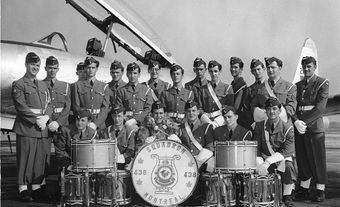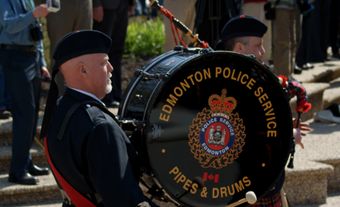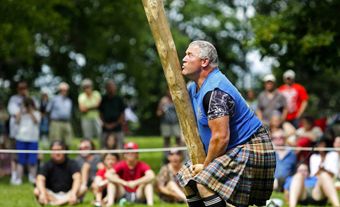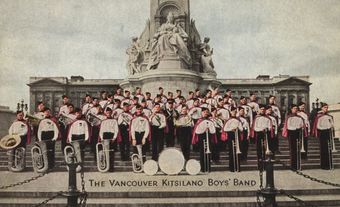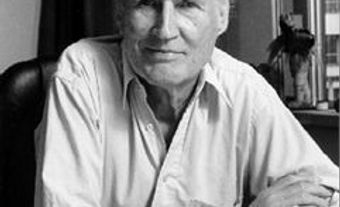Music bands are large instrumental ensembles consisting mainly of brass, woodwind, and percussion instruments. Traditionally, bands have been associated with outdoor activities or ceremonies, e.g., to accompany marching, add cheer to festivities, and contribute to the pomp of state occasions. The symphonic (concert) band is a modern refinement; the jazz and dance band are distant relations. The predominance of bands over orchestras and chamber ensembles was due also to the fact that band instruments can be learned more quickly than string or keyboard instruments. Furthermore, the extroverted music and vigorous sound of bands, their suitability for rousing patriotic emotions, and their usefulness in enhancing non-musical events made them popular.

New France
Military music in New France appears to have been limited to the sound of fifes, drums, and trumpets. When Pierre de Voyer d'Argenson, the governor of New France from 1658 to 1661, announced the intra missam on the main holy days, he had the fifes and tambours play, much to the annoyance of Bishop Laval, according to Auguste Gosselin (Vie de Mgr de Laval, vol 1, Quebec City 1890).
In the Carignan-Salières Regiment (the first regular troops in Canada; they arrived in 1665), each company had two tambours and one fife along with its 50 officers and soldiers. “The drums placed at the head of each company were used to keep the marching in order, to quicken it, to slow it down, and to rally to the flag all the scattered men” (Régis Roy and Gérard Malchelosse, Le Régiment de Carignan, Montreal 1925). A few of the tambours (drummers), Canada's earliest military musicians, are known by name: François du Moussart, Gugnot dit Le Tambour, and Jean Casavan (sic), a trumpeter and an ancestor of the Casavant organ builders. After three years of frontier warfare, the regiment returned to France, but some 400 men stayed in Canada. (See also Armed Forces Bands in Canada.)

British North America
It was only under the British regime, in the late 18th century, that larger regimental bands were sent to Canada. For about 150 years, bands remained the basis of instrumental ensemble performance in Canada. Band musicians (along with church organists) were the backbone of the musical profession. Their military employment provided a basic income that could be supplemented by teaching, playing church organs, dealing in musical merchandise, or perhaps repairing instruments.
The activities of the British regimental bands in Canada are documented amply in the travel literature and the diaries of the late 18th and early 19th centuries. A few quotations will suffice to draw a picture. On 2 March 1792, Elizabeth Simcoe, the wife of the first lieutenant-governor of Upper Canada, “gave a dance to forty people at Quebec. The Prince was present... The Fusiliers... are all musical and like dancing and bestow as much money as other regiments usually spend in wine, in giving balls and concerts, which makes them very popular in this place where dancing is so favourite an amusement” (The Diary of Mrs. John Graves Simcoe, 1791-1796, ed J. Ross Robertson, Toronto 1911, p 79).
Elsewhere Mrs. Simcoe reveals just how much was spent on the band. On 21 November 1791, she attended a subscription concert in Quebec City. “Prince Edward's band of the 7th Fusiliers played, and some of the officers of the Fusiliers. The music was thought excellent. The band costs the Prince eight hundred pounds a year” (ibid, p. 55). The program was mostly of Pleyel's music, including a symphony, a string quartet, and a concertante, and the Gazette reported on 28 November 1791 that “Beauty and Elegance partook of the most delightful Musical Fete ever remembered in this country, it being the first Winter Concert for the season. A more numerous band has not been seen together, nor a more numerous assemblage of ladies and gentlemen could not be well gathered together.” As in most such concerts, the band musicians were joined by civilian amateurs. Thus John Lambert, in his Travels through Canada and the United States of North America in the Years 1806, 1807, & 1808 (London, 3rd ed., 1816) confirms that at the occasional private concert in Quebec City, “the performers are some gentlemen of Quebec, assisted by a part of the regimental bands in the garrison.” Indeed, the Quebec City subscription concerts of the 1790s, the tentative Montreal orchestras of the 1890s, and the orchestras of many medium-sized cities in the mid-20th century would not have been able to function had they been unable to “borrow” band musicians.

Similar instances are documented in other cities. In Montreal, the first battalion band of the 60th, or Royal American, Regiment played “generally... for a couple of hours' on summer evenings on a public promenade (Canadian Antiquarian and Numismatic Journal, series 3, vol. 9, 1912, p. 106). Seventy years later, Samuel Phillips Day reported from Montreal, “The appearance of the troops on parade afforded much pleasure to the citizens; and when the military band performed on stated occasions in the Champ de Mars, the public was generally attracted thither” (English America, vol 1, London 1864, p 170).
Bands outside the British regiments came into existence around 1820. Early examples are the band of the Children of Peace in Hope (Sharon, Ontario) and the Musique Canadienne of Quebec City. Within a few decades, most towns and cities had bands, often associated with local fire brigades, temperance societies, or volunteer militia. Later in the century, bands were sponsored by municipalities, by such associations as the St-Jean-Baptiste and the Orange societies, or by manufacturers for their employees; e.g., the Taylor Safe Works Band of Toronto. (See also Civilian Bands in Canada.)
Types of Early Music Bands
Around the turn of the century, full-time Canadian military bands came into existence. After that time, the variety of ensembles grew: kiltie bands, Salvation Army bands, concert bands, broadcast and recording studio bands, Canadian Legion bands, football bands, cadet bands, and other varieties. Bands have been prominent among Canadian ambassadors of goodwill. Year after year, Canadian bands have toured the US, Europe, and other parts of the world, to participate in ceremonies, to enter contests, or to appear in festivals. (See also Police Bands in Canada; Highland Pipe Bands in Canada; School and Youth Bands in Canada.)

Notable Bandmasters
The following are among the more prominent band directors, active in the periods shown, who are entered or mentioned in the Encyclopedia of Music in Canada.
1800–50: J.-C. Brauneis I, Richard Coates, Frederick Glackemeyer, Charles Sauvageau, Adam Schott, François Vézina, James Ziegler Sr.
1850–1900: John Bayley, Peter Grossman, Edmond Hardy, Charles Lavallée, Ernest Lavigne, George R. Robinson, Joseph Vézina.
1900–50: L.F. Addison, Giuseppe Agostini, Fred A. Bagley, Edwin Bélanger, S.G. Chamberlain, H.L. Clarke, H.C. Ford, J.-J. Gagnier, René Gagnier, Joseph-Laurent Gariépy, J.-J. Goulet, Richard B. Hayward, François J.-A. Héraly, E. Reginald Hinchey, Charles O'Neill, Paul Pratt, Émile Prévost, Léon Ringuet, William F. Robinson, Spurgeon Sheppard, Henry Slatter, John Slatter, Charles F. Thiele, Alfred E. Zealley.
1950–90: William T. Atkins, B.G. Bogisch, Martin Boundy, Howard Cable, Morley Calvert, Leonard Camplin, Frank Connell, Arthur Delamont, Armand Ferland, A.C. Furey, Gérald Gagnier, J.M. Gayfer, Clifford Hunt, Ronald MacKay, F.M. McLeod, Jean-François Pierret, John Schoen, W. Bramwell Smith, Derek Stannard, Charles Villeneuve.
Composers and Arrangers
In addition to bandmasters themselves, other Canadian composers have written for band, especially Kenneth Campbell, Claude Champagne, Donald Coakley, Maurice DeCelles, Gordon Delamont, Robert Fleming, Harry Freedman, Graham George, A.W. Hughes, Lothar Klein, L.-P. Laurendeau, Calixa Lavallée, William McCauley, Paul McIntyre, Jack Sirulnikoff, Morris Surdin, John Weinzweig, Healey Willan, and Gerhard Wuensch. ( See also Band Music Composition.)

Associations
Perhaps the earliest was the Association des corps de musique de la province de Québec, founded by Edmond Hardy in 1887. A.L. Robertson and Charles Thiele were the main founders of the Ontario Amateur Bands Association in 1924 and the Canadian Bandmasters' Association in 1931. The latter was succeeded in 1973 by the Canadian Band Directors' Association.
The members of the Association des fanfares amateurs de la province de Québec, founded in 1928, appear to have been from the area between Montreal and Quebec City. In 1946, 40 member bands representing 16 towns met in Montreal for a combined concert. J.-Arthur Vinet of Valleyfleld was president of the association at that time. (See also Fédération des harmonies du Québec.)
The International Military Music Society (formed in 1977) established a Canadian branch with over 100 members, branch headquarters in Toronto, a monthly newsletter, and quarterly meetings in Toronto. A Canadian band research project was set up by the society.
Festivals and Competitions
Band festivals can be traced back to at least 1858 in Toronto. Bands competed in 1877 in Berlin (Kitchener), Ontario. The following year, 19 military and civilian bands, from as far away as Stratford and Waterloo in the west and Quebec City in the east, competed in Montreal. The Waterloo Musical Society in 1885 held a 16-band tournament, and this was followed by others in Ontario. Later competitions included those begun at the CNE in Toronto in 1921 and the Waterloo Band Festival, begun in 1932. (See also Music in Kitchener-Waterloo.)
See also Band Music Composition; Dance Bands; Armed Forces Bands in Canada; Civilian Bands in Canada; Police Bands in Canada; Highland Pipe Bands in Canada; School and Youth Bands in Canada.

 Share on Facebook
Share on Facebook Share on X
Share on X Share by Email
Share by Email Share on Google Classroom
Share on Google Classroom

